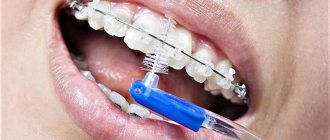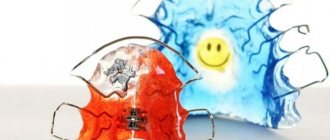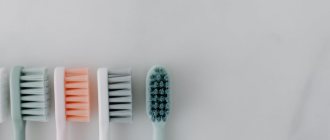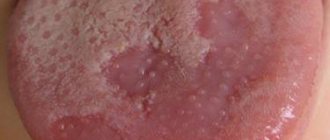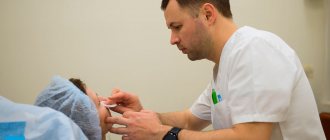For gum inflammation, doctors recommend a comprehensive approach to treatment. One effective option is the use of collagen plates, such as those produced by Farmadont. This product is unique and has no analogues; it contains collagen and natural plant components. According to patient reviews, positive dynamics are observed after the course of treatment. The plates are approved for use at any age. We will consider in more detail about the types and method of application below.
What are they needed for?
Dentists recommend using plates in the following cases:
- Gingivitis.
- Periodontitis.
- Bleeding gums.
- Periodontal disease.
- Injuries and damage to gums.
- Recent surgery, such as tooth extraction or implantation. Active components allow you to speed up the process of tissue regeneration.
The only contraindications can be identified as an allergic reaction. It is manifested by severe itching and increased swelling. In this case, you should thoroughly rinse your mouth with an antiseptic solution and stop treatment with Farmadont. Carefully study the composition before using the plates. Before use, consultation with a specialist is recommended.
In what specific cases is gingivoplasty needed?
When preparing for implantation, the following indications for gum augmentation may be identified:
- Loss of soft tissue caused by bone resorption in the area of a long-term missing tooth.
- Severe gum detachment resulting from periodontitis.
- Defects in the mucous membranes resulting from trauma to this area.
A sufficient volume of soft tissue during implantation is very important. It helps not only to qualitatively install an artificial root, but also to form an aesthetic gingival cuff around it. In addition, if the mucous membranes are in good condition, this contributes to normal nutrition of the bone structures. An implant that is tightly covered by the gum holds in the socket more firmly and is better protected from the penetration of bacteria. Therefore, the dental surgeon always investigates at the preparatory stage whether gum augmentation is necessary for implantation. And if such a need is identified, gingivoplasty is planned.
How to use it correctly
The plates are very easy to use:
- First, carry out a complete hygienic treatment of the oral cavity. Brush your teeth with toothpaste and a brush, use dental floss, mouthwash and irrigator.
- Wash your hands thoroughly with soap. Lightly massage your gums using your fingertips for 2-3 minutes.
- Then take the packaging and remove the plate.
- Remove the protective film and apply the product to the gum, firmly fixing and straightening the plate with your fingers.
- Close your jaws and wait for complete dissolution. It usually takes about 10 minutes, after which the plate dissolves on its own.
After the procedure, it is not recommended to eat or drink water for 1.5 hours. Depending on the specific diagnosis and severity of the pathological process, the doctor can establish an individual course of treatment. It is usually recommended to use the drug twice a day for 7-10 days. It is convenient to use the plates at night, in which case the therapeutic effect remains for a longer time.
The drug for the treatment of gums is affordable; it can be found in almost any pharmacy. The price is very reasonable; on average, a pack of plates (24 pieces) does not exceed 400 rubles.
Increasing the width of the keratinized gum area.
One of the varieties of this type of surgical intervention is vestibuloplasty:
Another name for such operations is “deepening the vestibule of the oral cavity”, “gum augmentation”, etc.
Why is it needed?
Reading articles on my website, especially this one or this one, makes you smile. Well, or twist your mouth in indignation. This happens thanks to the facial muscles that surround your mouth. Of course, they are needed not only for smiling - you talk, hold food in your mouth while chewing and, finally, just spit, too, thanks to the facial muscles.
These muscles, unlike other voluntary striated muscles, firstly, do not have fascia (dense connective tissue membrane), and secondly, they are attached to the bone with only one end - with the other end they are woven into soft tissue, providing that same facial expression.
So, in some people, due to morphological characteristics, the facial muscles (especially the chin) are attached to the lower jaw so high and with such a wide front that the depth of the vestibule of the oral cavity is significantly reduced. Together with the peculiarities of the mucosal phenotype, such anatomy increases the risk of developing periodontal diseases (especially if the bite is still incorrect) or, at a minimum, gum recession with all the ensuing aesthetic and functional consequences.
I would especially like to emphasize that the morphology of facial muscles, as well as the phenotype of the oral mucosa, is an individual feature, an inherited trait, such as eye color or ear shape. There are people with a low attachment of the mental muscle, and there are, on the contrary, with a high one.
In the latter, the risk of developing periodontitis and the appearance of gum recession is significantly higher, and therefore the logical solution in such cases seems to be, on the one hand, to deepen the vestibule of the oral cavity, eliminating the high attachment of facial muscles, on the other hand, to increase the width of the chewing gum area, thereby creating “protective buffer zone” for tooth roots.
What is “vestibuloplasty”?
The essence of the operation is to move the transitional fold below its natural position, with the expectation of healing and subsequent epithelization of the resulting wound.
There are many known options for the operation of deepening the oral cavity; the author’s methods alone (according to Glickman, Kruchinsky-Artyushkevich, Clark, Edlan-Meicher, Schmidt, etc.) number about a dozen. Some of them do not involve the formation of an open wound (for example, the so-called “tunnel technique”), others are carried out using a laser, radio scalpel or other prodigies. I would be happy to tell you about the comparative effectiveness of various methods and the advisability of using prodigies for this operation, but, unfortunately, I am limited to the topic of collagen matrices, and therefore next we will consider the simplest and most understandable method of vestibuloplasty using them.
When is it necessary?
Vestibuloplasty is necessary in cases of deficiency in the width of the area of the attached (masticatory) gum.
In turn, a deficiency of attached gums can be natural, due to the peculiarities of the morphological structure of the dental system, or acquired (for example, as a consequence of previously performed operations):
The main purpose of the operation is to eliminate the risk of gum recession in the area of natural teeth or implants. In the vast majority of clinical cases, this is a preventive procedure (like the removal of figure eights) designed to “relieve gum tension” in the vestibule of the oral cavity.
This is often necessary before, during or after orthodontic treatment, at the stages of complex treatment of periodontitis, peri-implantitis, etc.
In the remaining ten percent of cases, we consider vestibuloplasty as one of the stages of aesthetic mucogingivoplasty, for example, in preparation for flap surgery to eliminate gum recession. And very rarely, vestibuloplasty pursues any other goals (aesthetic, functional, etc.)
In our clinic, we most often perform such operations as preparation for orthodontic treatment, or in the process of orthodontic treatment in the direction of orthodontists. In second place is the prevention of peri-implantitis and/or periodontitis. On the third stage - gum plastic surgery as part of complex functional and aesthetic rehabilitation.
Pros and cons of using Mucograft for vestibuloplasty.
Whatever the purpose of vestibuloplasty, its implementation and the subsequent postoperative period are associated with a number of unpleasant sensations and the risk of possible complications.
– an open wound, formed as a result of moving and suturing the mucous membrane, bleeds and takes a long and painful time to heal. Sometimes, although very rarely, patients remain sensitive to temperature and chemical stimuli for a long time in the surgical area.
– it is almost never possible to maintain the width of the keratinized area of the gum formed during the operation – due to the formation of a scar, the wound contracts, the vestibule is slightly reduced and the depth is less than planned. The existing variety of techniques attempts to solve this problem, but none of the methods reliably solves it. And this, by the way, forces dentists, instead of neat and compact operations, to turn vestibuloplasty into a large-scale and very traumatic surgical intervention.
– due to uncontrolled scar formation, the opposite effect may occur - instead of growth, the gums will be pulled away from the roots of the teeth or implants, forming recessions.
– in case of special zeal on the part of the surgeon, there is a risk of infection and necrosis of the periosteum with all that it entails.
Well, in the end, this is just an unpleasant procedure with a long rehabilitation period, and this is often the reason for refusing to carry it out.
The use of Geistlich Mucograft collagen matrix partially solves the above problems:
Firstly , we do not leave an open wound. The collagen matrix implanted into it, together with the blood clot held in it, creates reliable protection for the underlying tissues.
Secondly, the collagen matrix isolates the wound from external irritants, significantly increasing the patient’s quality of life in the postoperative period.
Thirdly, it maintains the formed width of the chewing gum area, preventing scar contraction. Of course, it is still not possible to perfectly preserve the formed width, but the result is much better than using any modification technique.
Fourth, because the use of a collagen matrix increases the predictability of the surgical procedure, we do not need to deliberately increase the size of the surgical wound. And even in case of damage to the periosteum, Mucograft isolates it from the external environment, preventing infection and necrosis of bone tissue areas.
As for the minuses, there are two of them.
The first and most serious is the price. Yes, the use of biomaterials increases the cost of surgical intervention, at least by the cost of these same collagen matrices. In some cases, two or more times. Therefore, if we are talking about the rational use of Mucograft, then it is important to take into account the financial aspect. In particular, I do not see the advisability of its use during minor surgical operations (within 1-2 teeth) - in these cases, the use of SST or SDT, even open wound management, in such cases will not be too traumatic. And vice versa, when working in the area of 4-6-8 teeth, the trauma, scale and cost of the operation are already so great that the use of a collagen matrix no longer looks like an excessive solution or a “scam”.
The second disadvantage is due to the fact that Mucograft needs to be fixed correctly , and this takes a lot of time, requires patience and special manual skills. Many doctors refuse to work with collagen matrices only for the reason that “working with them is like hemorrhoids,” and this seems to contradict the main principle of using biomaterials (read here>> - it makes our work easier).
How is it carried out?
Unlike osteoplasty or implantation, soft tissue operations do not require any special instruments:
And, nevertheless, I must emphasize the choice of suture material and instruments for suturing the wound.
Suture material and needle holder
After long and painful deliberation, we came to the decision to use two types of suture materials for such operations.
To fix the mucous membrane to the periosteum, we use a 5-0 diameter resorbable polyfilament polylactide suture with a 3/8 back-cutting or piercing-cutting needle.
To fix the collagen matrix itself, another suture material is needed - monofilament non-resorbable polypropylene with a diameter of 5-0 or 6-0 with a piercing-cutting needle 1/2. Typically, vestibuloplasty in the area of the frontal group of teeth of the lower jaw takes about 60-75 cm of such thread.
And, since vestibuloplasty with a collagen matrix is exactly the kind of operation that requires a lot of sewing, in my professional opinion, the Castroviejo needle holder is most suitable for it. Preferably 18 cm long.
The rest of the tools, in principle, can be anything.
Anesthesia
We perform such operations ONLY under local anesthesia.
Firstly, it is much safer than sedation, not to mention anesthesia.
Secondly, the anesthetic helps us separate tissues during surgery (the so-called “hydropreparation”)
Thirdly, bleeding is reduced, which is important with such an extensive wound
Fourthly, it is much cheaper than any other type of anesthesia.
And in general, a surgeon who does not know how (or is afraid) to work under local anesthesia is not a surgeon at all, but rather... a pathologist.
Incision
The methods of vestibuloplasty of different authors differ from each other, first of all, in the shape of the incision.
The incision line runs just above the transitional fold (ideally, you need to capture 1-2 mm of the keratinized area of the gum) or directly along the transitional fold, if this is not possible otherwise. The length of the incision is 10-20% greater than the length of the intended area of vestibuloplasty.
We make the cut as follows:
The scalpel should be moved in one motion, without applying significant force. The key to a successful incision is to keep the periosteum intact and intact. This is easy if you hold the scalpel at an angle to the surface of the mucosa:
In relation to the described clinical situation, pay attention to this area:
We often see situations where the area of attached gum in the vestibule is, in principle, absent, in addition, all this is complicated by the presence of gum recession. In such cases, it makes sense to retreat 2-3 millimeters from the zenith of the tooth, even if the incision is within the mobile mucous membrane.
Another point - compare the left and right pictures, before and after the cut. Have you noticed that in the right picture “after the incision” the gum recession in the area of the central incisors has decreased slightly? This is due to a decrease in the tension of the mucous membrane attached to the periodontal sulcus, which, in my opinion, clearly justifies the need for vestibuloplasty before the stage of closing the recession using flap surgery. Therefore, as I wrote above, vestibuloplasty is often one of the stages of working with the soft tissues of the oral cavity and can precede flap operations.
Separation of tissues and creation of the vestibule
This is a key point in the entire operation, since both the result and the safety of the intervention will depend on the correct separation of tissues. We carry out this stage using raspatory or periotomes.
By the way, it is very convenient to use tools for open sinus lift.
As noted above, one of the factors for the success of the operation is maintaining the integrity of the periosteum. We create a wound in a “blunt” way, without using a cutting instrument. The mentalis muscle fibers are separated from the periosteum as much as possible using raspatory tools.
After creating the required height of the vestibule (do not forget to add + 50-100% for mucosal mobility), you can proceed to a more complex stage - fixing the mucous membrane to the periosteum.
Fixation of the mucous membrane to the periosteum
To do this, we use Viclryl 5-0 suture material with a 3/8 cutting-cutting or reverse-cutting needle. The choice of resorbable suture material is due to the fact that during the wound healing process, ligatures often grow in, and their removal is a serious problem. It is not necessary to remove Vicryl and similar materials.
First of all, the frenulum of the lower lip is fixed in a new position.
Next, the remaining suture ligatures are applied in a certain order:
The essence of the above procedure is exceptional ease of application and preservation of the ratio of the tissues being fixed. As a result of this stage, we obtain the previously planned depth of the vestibule of the oral cavity. And it would be great to preserve it.
However, due to the formation of a scar, we almost never succeed. On average, during the healing process of a wound, due to tissue tightening, it decreases by 50% or more. In addition, an open wound of such an area causes significant discomfort, can be complicated by infection and take quite a long time to heal.
The use of a collagen matrix, as noted above, is intended to eliminate these problems.
Application and fixation of collagen matrix
This is perhaps the most difficult, expensive and time-consuming stage of our operation. In part, it contradicts the stated principle of using biomaterials (“they should simplify our work”), but the use of a collagen matrix allows us to solve a number of postoperative problems and avoid complications, and therefore I find its use in vestibuloplasty necessary.
To deepen the vestibule in the area of the frontal group of teeth (from canine to canine), we use the Mucograft collagen matrix measuring 15x20 mm. It is more than sufficient in 99.99% of clinical cases where plastic surgery of the oral vestibule is required.
First, it needs to be prepared and adapted.
That is, from one collagen matrix measuring 15x20 cm we get two 7.5x20 cm, and this is more than enough for vestibuloplasty in the clinical situation under consideration.
Mucograft can be applied and fixed either dry or moistened. It's a matter of taste. I prefer to use the “dry” version, because it’s easier to fix it this way:
Please note that we capture the adapted matrix fragments one at a time. For fixation, we use non-resorbable monofilament suture material (the same Prolene or Polypropylene) with a diameter of 5-0 or 6-0 with a piercing or stabbing needle.
The technology of this stage looks simple - the collagen matrix is fixed at the edges with interrupted sutures, covering first one half of the wound, then the other. Fixation is completed by applying “pressing” sutures that fix the Mucograft to the periosteum:
Schematically, all sutures placed during vestibuloplasty will look like this:
In our clinic, such an operation lasts no more than 60 minutes:
Postoperative observation and recommendations
Through long-term observations of many clinical cases, we have reliably established that the use of a collagen matrix significantly reduces both discomfort and the risk of complications in the postoperative period (see above).
At the end of the appointment, we give the patient a memo with recommendations (we have it common for all mucogingival operations, it is possible), the essence of which boils down to the following:
– in order to avoid unnecessary injury to the surgical area , you should avoid rough, hot, spicy foods, especially dry food.
– in order to avoid bleeding , increased swelling and associated matrix separation, you should avoid a hot bath, sauna, limit physical activity, sports, etc.
– in order to avoid infection and the subsequent development of an infectious-inflammatory process , oral hygiene should be maintained at an acceptable level: to brush your teeth, use a soft toothbrush and a minimum amount of toothpaste, temporarily exclude the irrigator from the personal hygiene procedure.
– there is no need to treat the surgical area with ointments; you cannot make lotions or baths. It is pointless. The body will cope with regeneration on its own, without additional help.
Drug therapy:
Prescribing antibacterial agents (antibiotics) is most often not necessary. Their use is justified only in the case of existing preoperative (poor hygiene or difficulties with oral hygiene) and emerging intraoperative (damage to the periosteum, severe bleeding, etc.) risk factors. Fortunately, this rarely happens. Very rarely.
Anti-inflammatory painkillers are prescribed symptomatically , i.e. the patient himself decides whether to take them or not. Most often, we prescribe ibuprofen in dosages of up to 1200-1600 mg/day. for relief of postoperative pain syndrome in the first two days after surgery. In fact, for most patients, 200-800 mg/day is enough for a normal quality of life in the postoperative period.
Vitamin C (ascorbic acid) is involved in the synthesis of collagen from procollagen , and therefore I find its use after mucogingival operations justified. While the immunomodulatory and antiviral role of vitamin C is still a subject of debate, its positive effect on tissue regeneration in the postoperative period is undeniable. We prescribe vitamin C in a dosage of up to 2000 mg/day for two weeks - and this really helps to shorten the rehabilitation period and promotes safe healing of even such a large wound as remains after vestibuloplasty.
This is where the postoperative recommendations end. We can only observe the regeneration of the wound and the “transformation” of the collagen matrix into a normal mucous membrane.
We invite the patient for examination 1-2 days after surgery:
During the control inspection:
– We find out the patient’s complaints and well-being. As a rule, they are absent or minimal and are reduced to discomfort in the surgical area, the presence of suture ligatures and slight swelling. Pain syndrome after such operations is very, very rare.
– if necessary, we adjust drug therapy, prescribe/discontinue antibacterial drugs, etc.
– we remind and/or update recommendations for oral care.
- We schedule an appointment to remove the stitches. We usually begin (that is, we begin) removing sutures a week after surgery, removing only those ligatures that are convenient to remove. The process of removing sutures as they “cut through” the mucosa can take several weeks.
Evaluation of results.
A series of follow-up examinations at certain intervals in the postoperative period allows us to monitor and evaluate the results of the operation.
1. Assessing the patient’s quality of life in the postoperative period. Despite the apparent traumatic nature and scale of the surgical intervention, the postoperative period is almost not burdened by symptoms such as pain and bleeding. The patient's main complaints at this time are minor swelling, the presence of sutures in the oral cavity and associated discomfort.
2. Assessment of objective changes in the gums in the area of the operation. As I noted earlier, the use of collagen matrices does not completely eliminate, but significantly reduces scar contraction of the wound:
Sometimes we observe the effect of “thickening” of the mucous membrane:
Unfortunately, this effect is short-lived; follow-up studies have shown a significant decline in natural gingival thickness 1-2 years after surgery.
